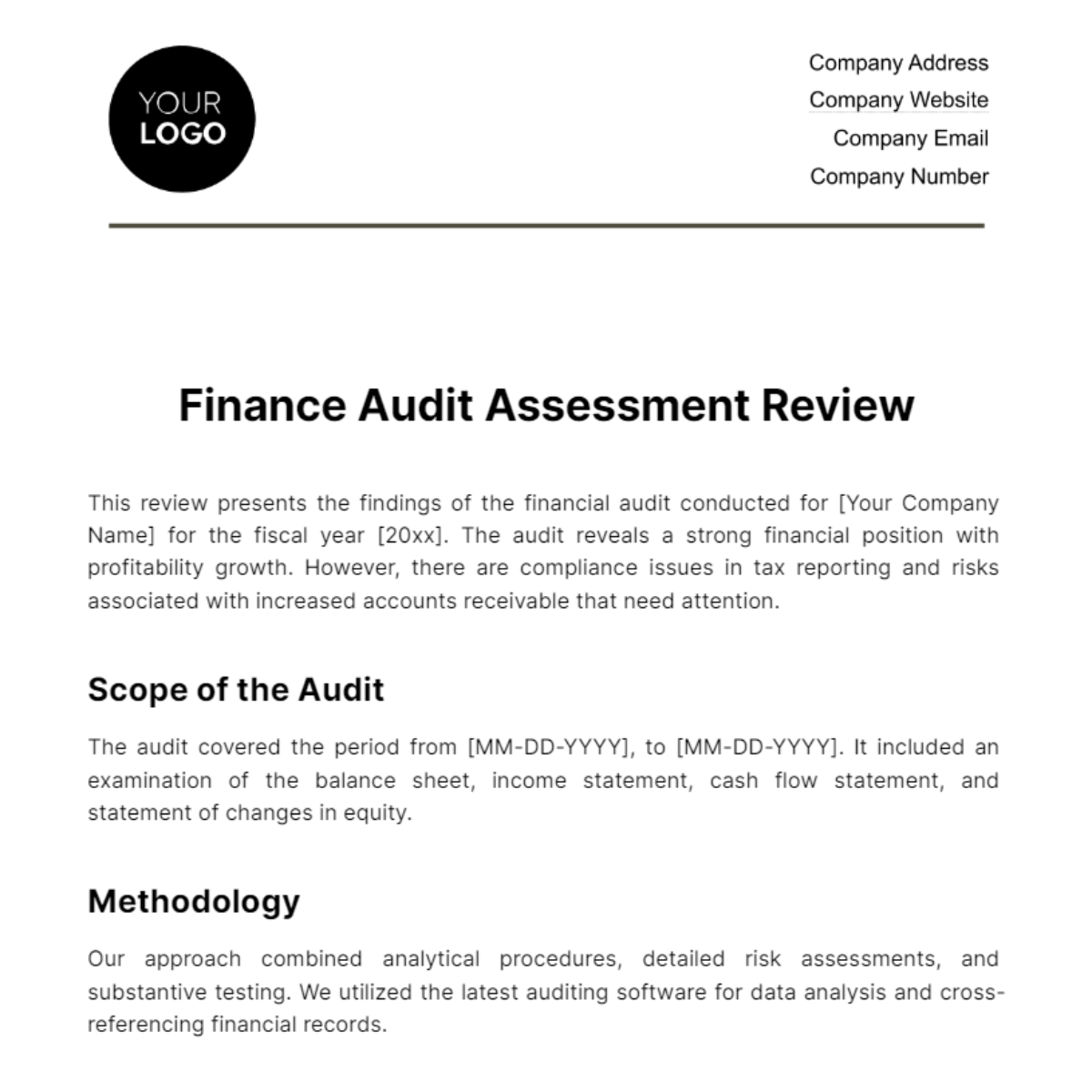Finance Audit Assessment Review
This review presents the findings of the financial audit conducted for [Your Company Name] for the fiscal year [20xx]. The audit reveals a strong financial position with profitability growth. However, there are compliance issues in tax reporting and risks associated with increased accounts receivable that need attention.
Scope of the Audit
The audit covered the period from [MM-DD-YYYY], to [MM-DD-YYYY]. It included an examination of the balance sheet, income statement, cash flow statement, and statement of changes in equity.
Methodology
Our approach combined analytical procedures, detailed risk assessments, and substantive testing. We utilized the latest auditing software for data analysis and cross-referencing financial records.
Financial Statement Analysis
Key Financial Ratios
Ratio Type | [20xx] | [20xx] |
|---|
Liquidity Ratio | 1.5 | 1.3 |
Profitability Ratio | 15% | 18% |
Debt-Equity Ratio | 0.8 | 0.7 |
Analysis: The company showed an improvement in profitability. However, a slight decrease in liquidity ratio suggests a need for better cash management strategies.
Compliance and Regulatory Findings
Findings:
Tax Reporting: The audit revealed discrepancies in tax filings, particularly in the under-reporting of certain deductible expenses. This includes misclassification of some operational expenses and failure to claim available tax deductions.
Regulatory Compliance: Minor lapses were noted in adherence to financial reporting standards, specifically in the areas of revenue recognition and lease accounting.
Implications:
These issues, while not severe, could lead to financial penalties and affect the company's reputation.
The under-utilization of deductible expenses has resulted in higher taxable income, leading to increased tax liabilities.
Corrective Measures:
Immediate revision of the tax reporting process is recommended.
Training for accounting staff on updated financial reporting standards and tax regulations.
Implementation of a more rigorous internal review process before tax filing.
Risk Assessment
The audit identified a potential credit risk linked to an increased accounts receivable turnover ratio, suggesting a review of credit policies.
Recommendations:
Implement a more robust vendor management system, including thorough background checks and performance reviews.
Introduce competitive bidding for major purchases and periodic audits of procurement activities.
Enhance training for procurement staff on best practices and internal control procedures.
Internal Control Evaluation
The evaluation of [Your Company Name]'s internal controls revealed a mixed landscape. While the company demonstrates robust controls in key operational areas such as cash management, sales, and payroll processing, notable vulnerabilities were identified within the procurement process. These weaknesses include insufficient vendor vetting practices and a lack of competitive bidding procedures. Such lapses in the procurement process can potentially lead to financial inefficiencies, such as overpayments, and even expose the company to risks of fraud.
Moreover, without stringent procurement controls, operational inefficiencies may escalate, resulting in unnecessary increases in costs. To address these concerns, we recommend the implementation of a more comprehensive vendor management system, which should encompass thorough background checks of suppliers and regular performance reviews.
Recommendations
Revise tax reporting procedures to ensure full compliance.
Implement stricter credit control policies to manage accounts receivable.
Strengthen internal controls in procurement.
Conclusion
[Your Company Name] has shown financial resilience and growth during the fiscal year [20xx]. While there are areas needing improvement, the overall financial health of the company is robust.






























